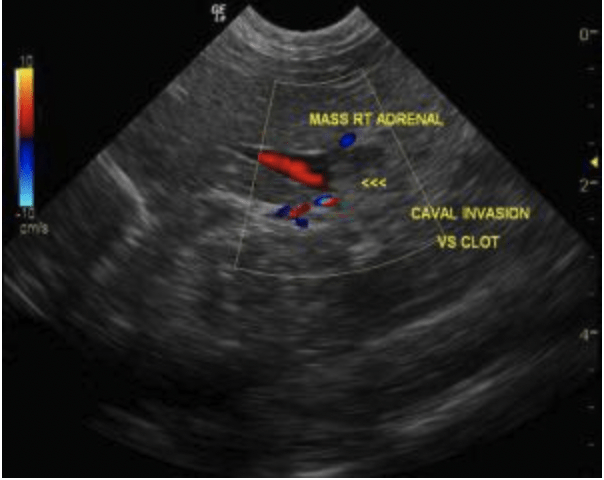History
This 14-year-old MN DSH presented for weight loss, increased respiratory effort, and progressive anorexia. The physical exam confirmed minor tachypnea, poor body score, grade 2/6 systolic heart murmur, but was otherwise normal. The CBC presented mild leukocytosis with a left shift. The blood chemistry was normal except for a moderate elevation in amylase and mild elevation in CPK. Urinalysis: PH 6.5, USG 1.026, glucose 2+, blood 3+, epithelia rare.
Clinical Differential Diagnosis
Pancreatitis, neoplasia, cardiac disease, feline asthma, Heartworm disease, thromboembolic disease causing the respiratory embarassment.
Sonographic Differential Diagnosis
Adrenal adenocarcinoma or pheochromocytoma with caval invasion, less likely benign hyperplasia with caval clot. Lung lesion: lung metastasis, thromboembolism, infammatory consolidation, infectious disease.
Sampling
Post mortem examination revealed right adrenal undifferentiated adenocarcinoma with medullary obliteration and confirmed pulmonary metastasis after histopathological review of the lesions presented here.
Comments
The lung lesion noted was only one of many diffuse lesions found on post mortem. The radiographs presented at the time of the sonogram were from 1 week prior and were interpreted as normal with no visible lung densities noted. This was one of 3 lesions that were close enough to the thoracic wall to obtain an echogenic window without lung air artifact. The patient was euthanized due to clinical decline 7 days post diagnosis. Referring Practitioner: Stacey Lipitz-Kilcullen DVM, Little Silver Animal Hospital, Little Silver, NJ, USA.
Patient Information
Age
Gender
Species
14 Years
Male, Neutered
Feline
